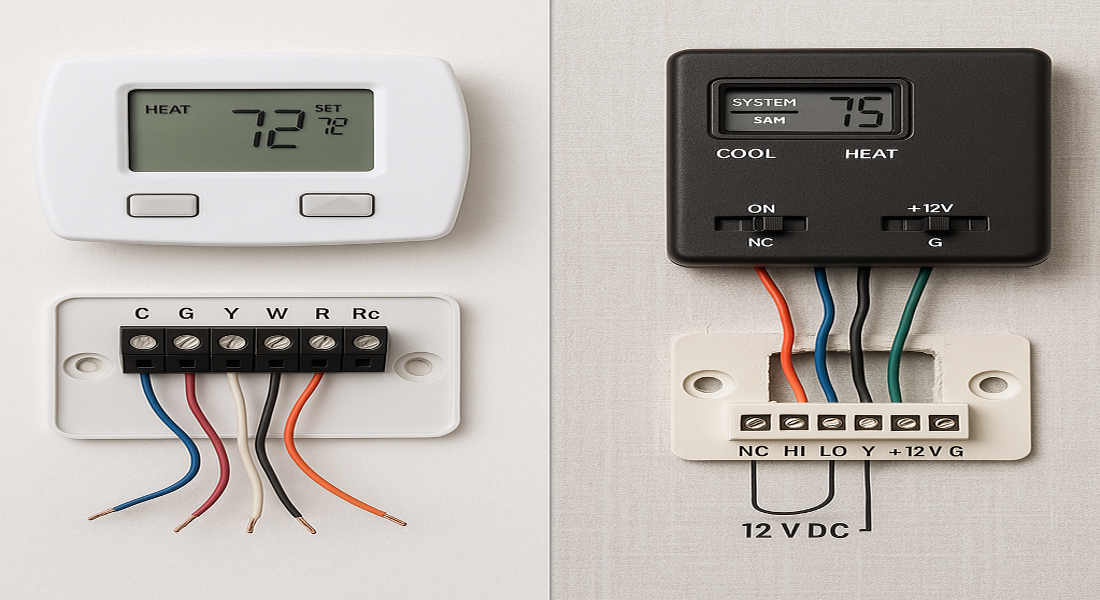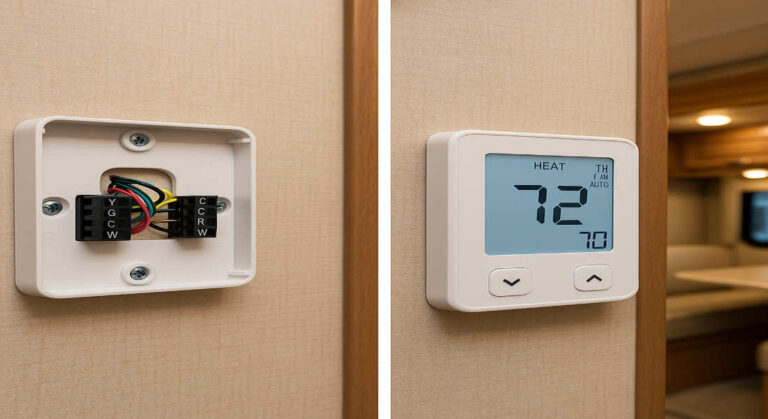Using a house thermostat in your RV requires understanding the key differences between residential and RV thermostat systems. Standard residential thermostats typically operate on 24-volt AC power, which is not available in RV electrical systems that primarily run on 12-volt DC power from the house battery. Therefore, residential thermostats cannot be directly installed in an RV without special adaptations. RV thermostats are specifically designed to work with the 12-volt DC system and function regardless of whether the RV is connected to shore power. They control heating and cooling systems, such as furnaces and air conditioners, by switching the appropriate power sources on and off to maintain the desired interior temperature. While smart thermostats are available for RVs, they must be specifically designed for RV use and compatible with the RV’s unique HVAC equipment. For those interested in using a house-style thermostat, options like the Micro Air Easy Touch smart thermostat are available. Still, they are specialized products rather than off-the-shelf home thermostats. Overall, using a house thermostat in an RV involves ensuring compatibility with the RV’s power system and HVAC controls to maintain comfort and avoid electrical issues.
The Benefits of Using a House Thermostat in Your RV
Using a house thermostat in your RV can significantly enhance your camping experience. It allows you to maintain a comfortable temperature without constant manual adjustments.
One significant benefit is energy efficiency. A programmable thermostat can help you save on power consumption by allowing you to set pre-set temperatures at different times of the day. This means less strain on your RV’s battery and resources.
These features enable remote access and monitoring from your smartphone, allowing you to adjust settings even when you’re away from the vehicle.
Comfort is key during travel, and having complete control over indoor conditions elevates the overall enjoyment of life on the road.
Step-by-Step Guide on How to Install a House Thermostat in Your RV
Installing a house thermostat in your RV isn’t as daunting as it sounds. Start by gathering the necessary tools: a screwdriver, wire strippers, and, of course, your new thermostat.
First, turn off the power to your RV’s heating and cooling systems for safety. Locate the existing thermostat, typically located on an interior wall. Remove it carefully to expose the wiring behind it.
Next, label each wire connected to the old unit. This will make installation easier later on. Disconnect the cables and set the old thermostat aside.
Now, it’s time for the new device. Following the manufacturer’s instructions, connect each labeled wire to the corresponding terminals on your new thermostat. Make sure everything is secure before reattaching any covers.
Restore power and test your installation by adjusting settings on your new thermostat to ensure proper functionality. Enjoy a more comfortable climate in your RV!
You may also read (how to heat your house 10 degrees efficiently).
Tips for Properly Using and Maintaining Your House Thermostat in an RV
To get the most out of your RV’s house thermostat, start with proper placement. Ensure it’s not exposed to direct sunlight or drafts. This will give you a more accurate reading and help maintain a consistent temperature.
Regularly check and replace the batteries in your thermostat if it is battery-operated. A low battery can lead to erratic behavior or complete failure.
Cleaning is essential as well. Dust and dirt can interfere with sensors, so wipe down the faceplate regularly to keep it clean.
Program settings according to your schedule for efficiency. Utilize features like “vacation mode” when you’re away for extended periods.
Please familiarize yourself with its functions by thoroughly reading the manual. Understanding how each setting works can enhance your comfort while minimizing energy consumption during your travels.
Common Mistakes to Avoid When Using a House Thermostat in an RV
One common mistake is failing to calibrate the thermostat. A house thermostat may not read temperatures accurately in an RV, especially if it’s placed near windows or heat sources.
Many RVs run on battery or generator power. Ensure your thermostat doesn’t drain resources too quickly, which can lead to unwanted temperature fluctuations.
Failing to perform regular maintenance can also lead to issues. Dust and dirt accumulation could hinder performance, so keep the unit clean for optimal function.
Avoid setting extreme temperature limits when parked in harsh climates. An overly high or low setting can put unnecessary stress on your heating or cooling systems and reduce efficiency over time.
You may also read (how to fix dampness in your home with ac on).
Alternative Options for Temperature Control in an RV
When considering how to manage temperature control in your RV, there are several options beyond using a house thermostat. One popular alternative is the use of a digital programmable thermostat. These devices enable more precise temperature settings and can often be programmed to adjust temperatures according to your schedule, providing both comfort and energy savings.
This enables remote control from your smartphone or tablet, allowing you to monitor and adjust the temperature even when you’re away from your RV. Smart thermostats also learn your habits over time, optimizing heating and cooling efficiency.
If you prefer a more manual approach, consider using portable heaters or fans, depending on the season. Electric space heaters can efficiently warm up smaller areas without relying solely on an HVAC system, while portable air conditioning units provide relief during hot summer days.
For those seeking eco-friendly solutions, solar-powered fans or vents can help circulate air naturally without drawing power from other sources.
Choosing the correct method may depend on factors such as the size of your RV, the climate conditions where you’ll be traveling, and personal preferences regarding convenience versus simplicity. Each option has its unique benefits that cater to different needs—experimenting with various methods might lead you to discover what works best for you!
You may also read (a guide to home etal in real estate explained).

